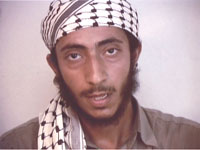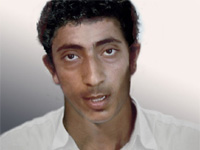The FBI Most Wanted Terrorists is a list created and first released on October 10, 2001, with the authority of United States President George W. Bush, following the September 11 attacks on the United States. Initially, the list contained 22 of the top suspected terrorists chosen by the FBI, all of whom had earlier been indicted for acts of terrorism between 1985 and 1998. None of the 22 had been captured by US or other authorities by that date. Of the 22, only Osama Bin Laden was by then already listed on the FBI Ten Most Wanted Fugitives list.

Ramzi bin al-Shibh is a Yemeni citizen being held by the U.S. as an enemy combatant detainee at Guantanamo Bay in Cuba. He is accused of being a "key facilitator for the September 11 attacks" in 2001 in the United States.
Said Bahaji, was a citizen of Germany, electrical engineer, and an alleged member of the Hamburg cell that provided money and material support to the perpetrators of the September 11 attacks.

Adnan Gulshair el Shukrijumah was a citizen of Saudi Arabia and a senior member of al-Qaeda. He was born in Saudi Arabia and grew up in the United States.

Walid Muhammad Salih bin Mubarak bin Attash is a Yemeni prisoner held in extrajudicial detention at the United States' Guantanamo Bay detention camp.

Abderraouf bin Habib bin Yousef Jdey is a Canadian citizen, who was found swearing to die as a shaheed (martyr) on a series of videotapes found in the rubble of Mohammed Atef's house in Afghanistan in 2002.
Fawaz Yahya al-Rabeiee was an al-Qaeda terrorist, sentenced to death in 2004 by a Yemeni court for his part in the 2002 attack on the French tanker Limburg. Al-Rabeiee escaped custody in February 2006, with 22 other inmates, but was killed 1 October 2006 in San‘a’, along with another al-Qaeda suspect identified as Mohammed Daylami.
On September 11, 2001, 19 Muslim hijackers took control of four commercial aircraft and used them as suicide weapons in a series of four coordinated acts of terrorism to strike the World Trade Center in New York City, The Pentagon in Arlington County, Virginia, and an additional target in Washington, D.C. Two aircraft hit the World Trade Center while the third hit the Pentagon. A fourth plane did not arrive at its target, but crashed into a field in Pennsylvania after a passenger revolt. The intended target is believed to have been either the United States Capitol or the White House. As a result, 2,977 victims were killed, making it the deadliest foreign attack on U.S. soil, exceeding Japan's surprise attack on Pearl Harbor in Honolulu, Hawaii, on December 7, 1941, which killed 2,335 members of the United States Armed Forces and 68 civilians. The effort was carefully planned by al-Qaeda, which sent 19 terrorists to take over Boeing 757 and Boeing 767 aircraft, operated by American Airlines and United Airlines.
A Syrian-Kurd, Abd Al-Rahim Abdul Rassak al-Janko is a former student in the United Arab Emirates who traveled to Afghanistan in 2000, where he was captured by the Taliban who announced that he had confessed to plotting to murder Osama bin Laden, as well as spying against the Taliban on behalf of Israel and the United States. He was also denounced for "his sexual indiscretions with other young men" and accused of homosexuality. Following the Invasion of Afghanistan, al-Janko begged a British journalist to alert the Americans that he had been held prisoner by the Taliban for two years; however, he was taken from the Taliban prison by American forces, and sent to the Guantanamo Bay detention camps where he spent seven years in detention.

The FBI Seeking Terror Information list is the third major "wanted" list to have been created by the United States Department of Justice's Federal Bureau of Investigation to be used as a primary tool for publicly identifying and tracking down suspected terrorists operating against United States nationals at home and abroad. The first preceding list for this purpose was the FBI Ten Most Wanted Fugitives list. In 2001, after the September 11 attacks, that list was supplanted by the FBI Most Wanted Terrorists list, for the purpose of listing fugitives who are specifically wanted for acts of terrorism.

Faker Ben Abdelazziz Boussora born March 22, 1964 in Tunisia) is a Canadian citizen, and a senior member of al-Qaeda. He is being sought in connection with possible terrorist activity within the United States, with a US$5 million bounty on his head by American authorities. He also went by the name Abu Yusif al-Tunisi.

Khalid Mohammad bin Muslim Al-Arawi Al-Juhani was a Saudi member of al-Qaeda. He appeared, cradling a rifle, in a 2002 videotape in which he promised a "martyrdom" attack. In 2003, the Saudi government identified al-Juhani as one of twelve dead perpetrators of the Riyadh compound bombings based on DNA found at the scene.
Ahmad al-Akhader Nasser Albidani, , became briefly wanted in 2002, by the United States Department of Justice's FBI, which was then seeking information about his identity and whereabouts. In early 2002, he had been named in a suspected Yemen plot, for which he became listed on the FBI's third major "wanted" list, now known as the FBI Seeking Information - War on Terrorism list. He was identified as a known associate of the Yemen cell leader, Fawaz Yahya al-Rabeei. But he was quickly discovered to already be in Yemen prison, and was promptly removed from the FBI "wanted" list. Very little else is known about him.
Abdulaziz Muhammad Saleh bin Attash, , became briefly wanted in 2002, by the United States Department of Justice's FBI, which was then seeking information about his identity and whereabouts. In early 2002, he had been named in a suspected Yemen plot, for which he became listed on the FBI's third major "wanted" list, now known as the FBI Seeking Information - War on Terrorism list. He was identified as a known associate of the Yemen cell leader, Fawaz Yahya al-Rabeei. But he was quickly discovered to already be in Yemen prison, and was promptly removed from the FBI "wanted" list. He was the brother of Walid bin Attash and Hassan bin Attash.
Shuhour Abdullah Mukbil al-Sabri, , became briefly wanted in 2002, by the United States Department of Justice's FBI, which was then seeking information about his identity and whereabouts. In early 2002, he had been named in a suspected Yemen plot, for which he became listed on the FBI's third major "wanted" list, now known as the FBI Seeking Information - War on Terrorism list. He was identified as a known associate of the Yemen cell leader, Fawaz Yahya al-Rabeei. But he was quickly discovered to already be in Yemen prison, and was promptly removed from the FBI "wanted" list. Very little else is known about him.

Saleh Ali Saleh Nabhan was the leader of al-Qaeda in Somalia. He was listed on the FBI's third major "wanted" list, the FBI Seeking Information - War on Terrorism list, for his association with multiple attacks in Kenya in 2002, as well as his possible involvement in the 1998 United States embassy bombings, in which over 250 people lost their lives.
This page lists trials related to the September 11, 2001 terrorist attacks.
Muhammad Abdallah Hasan Abu-al-Khayr, also known as Abu Abdallah al-Halabi, was a citizen of Saudi Arabia notable for being named on its 2009 list of most wanted suspected terrorists. He was alleged to be one of Osama bin Laden's bodyguards, and one of his sons-in-law.
At around 9:30 pm on September 11, 2001, George Tenet, director of the Central Intelligence Agency (CIA) told the president and U.S. senior officials inside the bunker underneath the White House that the CIA's Counterterrorism Center had determined that Osama Bin Laden and al-Qaeda were behind the September 11 attacks. Two weeks after 9/11, the Federal Bureau of Investigation connected the hijackers to al-Qaeda, a militant Salafist Islamist multi-national organization. In a number of video, audio, interview and printed statements, senior members of al-Qaeda have also asserted responsibility for organizing the September 11 attacks.

Mohammed Atef was the military chief of al-Qaeda, and was considered one of Osama bin Laden's two deputies, the other being Ayman Al Zawahiri, although Atef's role in the organization was not well known by intelligence agencies for years. He was killed in a US airstrike in November 2001.










